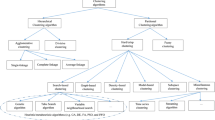Abstract
Clustering algorithms have been applied to different problems in many different real-word applications. Nevertheless, each algorithm has its own advantages and drawbacks, which can result in different solutions for the same problem. Therefore, the combination of different clustering algorithms (cluster ensembles) has emerged as an attempt to overcome the limitations of each clustering technique. The use of cluster ensembles aims to combine multiple partitions generated by different clustering algorithms into a single clustering solution (consensus partition). Recently, several approaches have been proposed in the literature in order to optimize or to improve continuously the solutions found by the cluster ensembles. As a contribution to this important subject, this paper presents an investigation of five bio-inspired techniques in the optimization of cluster ensembles (Genetic Algorithms, Particle Swarm Optimization, Ant Colony Optimization, Coral Reefs Optimization and Bee Colony Optimization). In this investigation, unlike most of the existing work, an evaluation methodology for assessing three important aspects of cluster ensembles will be presented, assessing robustness, novelty and stability of the consensus partition delivered by different optimization algorithms. In order to evaluate the feasibility of the analyzed techniques, an empirical analysis will be conducted using 20 different problems and applying two different indexes in order to examine its efficiency and feasibility. Our findings indicated that the best population-based optimization method was PSO, followed by CRO, AG, BCO and ACO, for providing robust and stable consensus partitions.


Similar content being viewed by others
References
Aggarwal CC, Reddy CK (2013) Data clustering: algorithms and applications. Chapman & Hall/CRC, Boca Raton
Asuncin A, Newman DJ (2012) UCI machine learning repository. http://ics.uci.edu/~mlearn/MLRepository.html
Azimi J, Cull P, Fern X (2009) Clustering ensembles using ants algorithm. Springer, Berlin, pp 295–304
Chatterjee S, Mukhopadhyay A (2013) Clustering ensemble: a multiobjective genetic algorithm based approach. In: International conference on computational intelligence: modeling, techniques and applications (CIMTA), pp 443–449
Dorigo M (1992) Optimization, learning and natural algorithms
Esmin AAA, Coelho RA (2013) Consensus clustering based on particle swarm optimization algorithm. In: 2013 IEEE international conference on systems, man, and cybernetics, pp 2280–2285. IEEE
Everitt BS, Landau S, Leese M, Stahl D (2011) Optimization clustering techniques. Wiley, London, pp 111–142. https://doi.org/10.1002/9780470977811.ch5
Faceli K, Lorena AC, Gama J, de Leon Ferreira de Carvalho ACP (2011) Artificial intelligence: a machine learning approach (in portuguese). LTC, Rio de Janeiro
Fred A, Lourenço A (2008) Cluster ensemble methods: from single clusterings to combined solutions. Springer, Berlin, pp 3–30
Ghaemi R, Sulaiman Nb, Ibrahim H, Mustapha N (2011) A review: accuracy optimization in clustering ensembles using genetic algorithms. Artif Intell Rev 35(4):287–318
Hall M, Frank E, Holmes G, Pfahringer B, Reutemann P, Witten IH (2009) The weka data mining software: an update. SIGKDD Explorations 11(1)
Holland JH (1992) Genetic algorithms. Sci Am 267(1):66–72
Hu J, Li T, Wang H, Fujita H (2016) Hierarchical cluster ensemble model based on knowledge granulation. Knowl-Based Syst 91(C):179–188
Hutter F, Hoos HH, Leyton-Brown K, Stützle T (2009) Paramils: an automatic algorithm configuration framework. J Artif Int Res 36(1):267–306
José-García A, Gómez-Flores W (2016) Automatic clustering using nature-inspired metaheuristics. Appl Soft Comput 41(C):192–213
Karaboga D (2005) An idea based on honey bee swarm for numerical optimization. Technical Report TR06, Erciyes University
Karaboga D, Basturk B (2008) On the performance of artificial bee colony (abc) algorithm. Appl Soft Comput 8(1):687–697
Kennedy J, Eberhart R (1995) Particle swarm optimization. In: Neural networks, 1995. Proceedings, IEEE international conference on, vol 4, pp 1942–1948
Kuncheva LI (2004) Combining pattern classifiers: methods and algorithms. Wiley, New Jersey
Medeiros IG, Xavier-Jnior JC, Canuto AMP (2015) Applying the coral reefs optimization algorithm to clustering problems. In: International joint conference on neural networks (IJCNN). Proceedings of international joint conference on neural networks (IJCNN) vol 1, pp 1–8
Nisha MN, Mohanavalli S, Swathika R (2013) Improving the quality of clustering using cluster ensembles. In: Proceedings of 2013 IEEE conference on information and communication technologies (ICT 2013), pp 88–92. IEEE
Salcedo-Sanz S, Gallo-Marazuela D, Pastor-Sánchez A, Carro-Calvo L, Portilla-Figueras A, Prieto L (2014) Offshore wind farm design with the coral reefs optimization algorithm. Renew Energy 63:109–115
Salcedo-Sanz S, Casanova-Mateo C, Pastor-Sánchez A, Sánchez-Girn M (2014) Daily global solar radiation prediction based on a hybrid coral reefs optimization 17 extreme learning machine approach. Sol Energy 105:91–98
Salcedo-Sanz S, García-Díaz P, Portilla-Figueras JA, Ser JD, Gil-López S (2014) A coral reefs optimization algorithm for mobile network optimal deployment with electromagnetic pollution control criterion. Appl Soft Comput 24:239–248
Salcedo-Sanz S, Pastor-Sánchez A, Ser JD, Prieto L, Geem Z (2015) A coral reefs optimization algorithm with harmony search operators for accurate wind speed prediction. Renew Energy 75:93–101
Salcedo-Sanz S, Ser JD, Landa-Torres I, Gil-López S, Portilla-Figueras JA (2014) The coral reefs optimization algorithm: a novel metaheuristic for efficiently solving optimization problems, vol 2014. Sci World J
Silva HM, Canuto AMP, Medeiros IG, Xavier-Júnior JC (2016) A bio-inspired optimization technique for cluster ensembles optimization. In: The 5th Brazilian conference on intelligent system (BRACIS). IEEE
Simon D (2013) Evolutionary optimization algorithms: biologically inspired and population-based approaches to computer intelligence
Sulaiman N, Ghaemi R, Ibrahim H, Mustapha N (2009) A survey: clustering ensembles techniques. World Acad Sci Eng Technol 38:636–645
Topchy A, Jain AK, Punch W (2003) Combining multiple weak clusterings. In: Proceedings of the IEEE international conference on data mining (ICDM172003). Melbourne, Florida, USA, pp 331–338
Yang LY, Zhang JY, Wang WJ (2009) Cluster ensemble based on particle swarm optimization. In: Global congress on intelligent systems, pp 519–523. IEEE
Zhong C, Yue X, Zhang Z, Lei J (2015) A clustering ensemble: two-level-refined co-association matrix with path-based transformation. Pattern Recognit 48(8):2699–2709
Acknowledgements
This work has been financially supported partially by Capes/Brazil.
Author information
Authors and Affiliations
Corresponding author
Rights and permissions
About this article
Cite this article
Canuto, A., Neto, A.F., Silva, H.M. et al. Population-based bio-inspired algorithms for cluster ensembles optimization. Nat Comput 19, 515–532 (2020). https://doi.org/10.1007/s11047-018-9682-1
Published:
Issue Date:
DOI: https://doi.org/10.1007/s11047-018-9682-1




